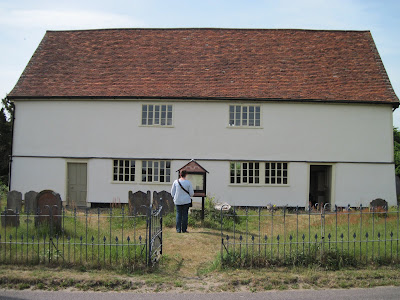"So may the outward shows be least themselves, the world is still deceived by ornament", wrote an oft-quoted Seventeenth century play-write. In this instance, however, the 'world' of post-Restoration English authority might be said to have been deceived by a distinct lack of ornament. For, although it would appear that you are looking at a typical timber-framed Suffolk farmhouse, this is, in fact, a trick of the eye...
... for when you step inside, a surprise awaits. For here, you are entering Walpole Old Chapel, a galleried and box-pewed meeting house, converted in the late Seventeenth century by Nonconformists seeking sanctuary to worship in peace. Peace that is, from the newly restored Royalist regime of Charles the Second, with its heavy handed attempts to impose the old Anglican practices on an often resistant population. The dissenting 'cat' was well and truly out of the bag however; without ornamentation or what they would've seen as 'Popish superstition', the congregation were focused on the pulpit and lectern - by very deliberate design, preaching delivered the Word to the gathered flock.
This seeming attempt at deception begs a question however. Is it credible to imagine that the authorities were so easily deceived? I think not. Instead, I think it more than likely that the prevailing powers were very well aware of what was going on within these walls. When congregations of several hundred were gathered within, there is no way that this could be kept secret from the world beyond. Perhaps, therefore, this is more about a kind of tacit stand-off between Anglican authority and their Nonconformist 'enemy within'. So long as the dissenters did not flout their practices in the eyes of officialdom, they might be tolerated to continue to congregate thus. Of course, a lack of ostentation, ornamentation and display was entirely in keeping with the Nonconformist ethos anyway. In the uneasy 'peace' of the Restoration, there was to be no repeat of the clumsy suppressions of the pre-civil war Archbishop Laud. Forgive me my mixed metaphors, but too blunt a fist might spark the tinder of righteous 'puritan' fury. Who knows who might lose their head when hot-headed/heartfelt belief is given a cause to oppose, head on (so to speak!). Not so much deception then; discretion was to be the watchword of these more precarious days.
Aside from my speculations however, let us consider this wonderful building from some other perspectives...
To my eyes, the rough-hewn timber of 'barn built' benches presents a rustic, rickety spectacle; a product of honest toil which I find most pleasing. Without thinking, I found myself tenderly running my hand over the quirkily uneven surfaces. This is the rough and ready work of practical men; functional, without even the slightest hint of ornamentation. With that touch, I felt connected to the presence of dead generations. And in this moment, as I sat basking in the dusty rays of sunlight, I was struck by the transience of all things.
Up here, in the gallery, sat servants, apprentices and children; flanked by men to the south and women to the north. In this place of human touches, little surprise to find that restless hands have left their mark...
There are just so many stories to tell here, but it is important not to crowd out the 'magic' of this space with too much babble and information. The honest simplicity of the space almost palpably whispers to a sensitive Rambler of a Ragged persuasion, inviting one to leave the bustling world outside and be at peace.
Finally - and in no way, least of all -, I would like to recognise the contribution of the volunteers who were present on the day we visited. First and foremost, they greeted us warmly and made us feel genuinely welcome. Secondly, they 'read' us correctly. We were happy to be told about the history of this place. Accordingly, we were treated to a cogent and interesting summary, presented by a charming and engaging man who, in the time-honoured best practice of the historical interpreter, left us wanting more.
Afterwards, we stepped out into the sunshine and enjoyed a picnic in the chapel grounds. As we ate our provisions and drank from our flasks, we watched with delight as family of Housemartins fed their young, nested in the eaves of the building.
If, as I sincerely hope you will, you wish to visit Walpole Old Chapel (a short distance south of Halesworth in north Suffolk), then go to their website for more details (click on, either, the live link in the first paragraph of this post, or on the link to their website on the sidebar of this blog).
Composed by Esotericus









Addendum: the place even has a new toilet block; clean and complete with freshly laundered towels... the final thoughtful human 'touch' I shall mention here ;-)
ReplyDeleteSounds wonderful. And how sympathetically maintained.
ReplyDeleteGreat photos and as usual well written. madeleine
ReplyDelete